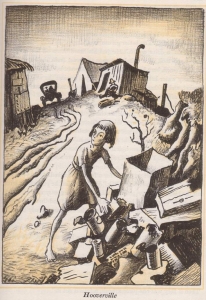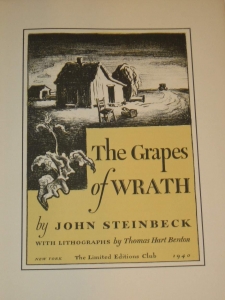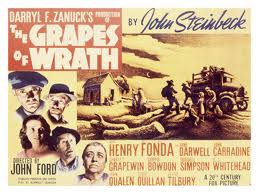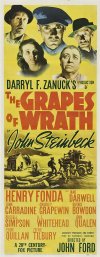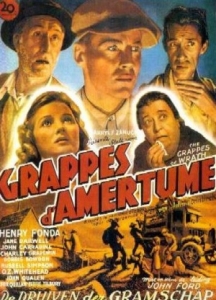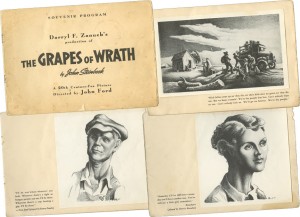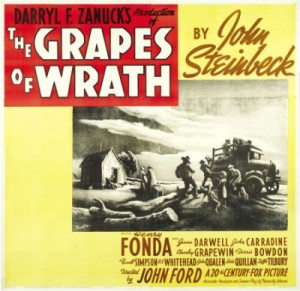 The Grapes of Wrath, 1940
The Grapes of Wrath, 1940
Advertising poster by 20th Century Fox for the movie, The Grapes of Wrath
Soon after John Steinbeck’s influential novel, The Grapes of Wrath, was first published in 1939, positive popular reaction to the story* impelled the Limited Editions Club** to publish its own version illustrated by the American Regionalist painter, Thomas Hart Benton. Late in the 1920s Benton had begun focusing his work on the lives and landscapes of contemporary America. The painter also began to delve into illustration art when he produced images for a Marxist history of the United States, We, the People, written by Leo Huberman. Illustration was a natural leap for Benton the painter due to his training at the School of the Art Institute of Chicago in the fields of illustration and newspaper cartooning.
The next illustrations Benton produced were for the publication of Mark Twain’s Tom Sawyer for the Limited Editions Club in 1939.** Benton’s illustrations for The Grapes of Wrath included full page two-color lithographs, and chapter head pieces and tail pieces in black and white—61 illustrations in total.
Like Twain’s rural Missouri boy adventure stories*** Steinbeck’s tale of Okie sharecroppers (leaving home in Sallisaw, Oklahoma for a better life in California) begins within the realm of Benton’s personal sphere, about 40 miles south from where he grew up in southwest Missouri.**** So Benton’s illustrations were focused on what was for him was a visually familiar world. The people and their plight was one Benton had witnessed and chronicled in his own drawings and paintings.
Thomas Hart Benton ((1889-1975)
Hooverville, c. 1940 Title page, c. 1940
Story illustrations for John Steinbeck’s The Grapes of Wrath (New York: The Limited Edition Club, 1940)
Lithograph
When 20th Century-Fox sought an image to use as the focus for their promotional posters for Darryl F. Zanuck’s production of The Grapes of Wrath directed by John Ford in 1940, they hired Thomas Hart Benton to create an illustration they could incorporate into their advertising.***** Benton used a painting of one of story illustrations, Departure of the Joads, he’d created for the book.
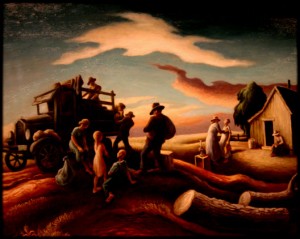 Thomas Hart Benton ((1889-1975)
Thomas Hart Benton ((1889-1975)
The Departure of the Joads, 1940
Advertising illustration commissioned by 20th Century Fox for poster for the movie, The Grapes of Wrath
Egg tempera and oil paint on a support
Painting in the collection of the RalphForsterMuseum, College of the Ozarks
Painted in Benton’s inimitable style, Departure shows the extended Joad family outside their Oklahoma home loading their truck with their transportable possessions. As dark and ominous as Benton’s painting appears, he also gave it a hopeful aura in the blue over-arching sky and the pinking of the clouds as the sun sets. Back at their cabin Grandfather Joad sits next to the open door ignoring the rest of the family as he steadily resists the notion of leaving home. Notice the cut logs in the foreground of the painting and see how they set the stage and then reinforce the undulation of the land that places the front of the truck on a visible downhill slant with its headlights pointed out beyond the picture and into the future. While the advertising posters that incorporated Benton’s illustration include all of this detail, it was mostly reproduced in sepia or gray tones, and sometimes even overlaid with print. Also notice that the advertising image is flipped, as was common for a reproduced print, and faces the opposite direction of the painting.
Benton also created a series of drawn portrait images of the story’s main characters for the studio, but these were not used in the posters—other drawings based on the movie’s actors (and later photos) were created by someone else and floated on the various posters in a variety of locations and designs.
The poster on the far right is a Belgian version. I should note that not all the advertising posters for this movie included Benton’s illustration.
But Benton’s character illustrations did not go to waste. The studio produced a souvenir program to promote the opening of the movie that included the character portrait illustrations Benton created for the film.
The book and movie versions of Steinbeck’s The Grapes of Wrath quickly entered the American literary and film cannons. Just as Uncle Tom’s Cabin had influenced the debate on slavery in the mid-19th century before the Civil War, The Grapes of Wrath focused Americans on the plight of victims of the dust bowl and the life of migrant workers. Even though in 1940 war loomed large, the American public then and ever after use the book to help understand one aspect of the struggle of life in depression era America. Thomas Hart Benton’s illustrations are a part of this history.
* The Grapes of Wrath won the National Book Award in 1939; received a Pulitzer prize in 1940; and was awarded the Nobel Prize in literature in 1962 with this book cited prominently in the award.
** The Limited Editions Club, founded in 1929, focused on publishing fine editions of literature classics and a few carefully selected contemporary titles. These volumes were illustrated by leading book illustrators who hand-signed each copy of the book they illustrated for the LEC.
*** Benton would continue to produce illustrations for The Limited Editions Club including for a publication of the play, Green Grow the Lilacs, and for Twain’s Adventures of Huckleberry Finn. Benton continued to created illustrations for books and even for cigarette ads for Lucky Strike.
**** a.k.a. brazen boy stories as described in previous Exploring Illustration posting “Women Who Read”, https://www.rockwell-center.org/exploring-illustration/women-who-read/
***** See, Henry Adams, “Thomas Hart Benton’s Illustrations for The Grapes of Wrath” in San Jose Studies v. XVI, no. 1 (Winter 1990): 6-18.
****** By 1937 Norman Rockwell had already begun to produce illustration images for Hollywood movie studios to incorporate into their poster advertisements: Along Came Jones (1937); The Adventures of Marco Polo (1938); The Magnificent Ambersons (1942); The Song of Bernadette (1944); The Razor’s Edge (1946); Sampson and Delilah (1949); Cinderfella (1960); and Stagecoach (1966). Benton did one more movie poster illustration for the 1955 production of The Kentuckian produced by United Artists and directed by Burt Lancaster. Benton made the face of the title character look like Lancaster.
May 2, 2013
By Joyce K. Schiller, Curator, Rockwell Center for American Visual Studies, Norman Rockwell Museum


